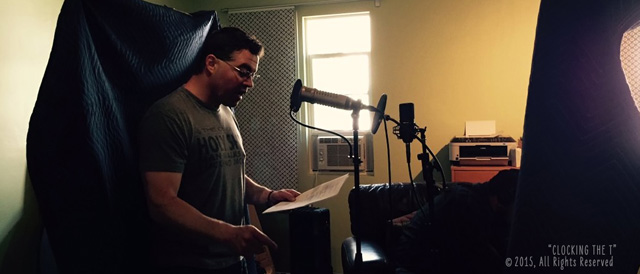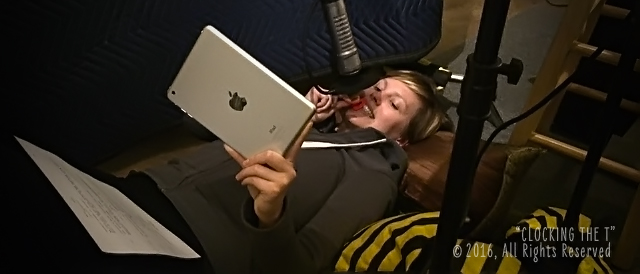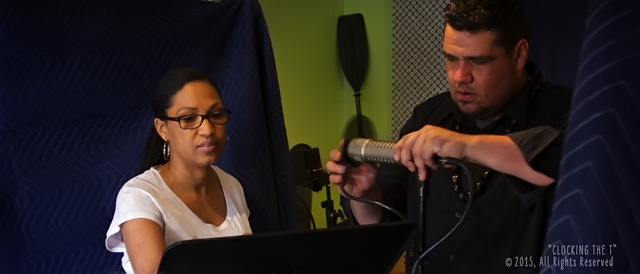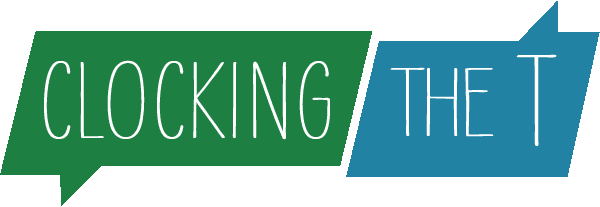Twenty-First Century Mulligan
03/30/16 10:23 Filed in: Post Production
We've been looping the movie the last couple of weeks, with actors flying in and out of the edit bay as they're available—which is a toughie when we're all juggling day jobs and the leads have a fistful of sides. But it's getting done. And here's how we did it on the cheap…


Wait.
Maybe we should start with how it's Actually Done.

Looping goes back to the talkie days when they would replace the audio of a dialogue line by recording it in a studio by playing ‘loops’ of 35mm film through a projector, endlessly cycling as the actors watched a screen and timed their performance to the repetition projected in front of them. Nowadays, it’s all computer driven, hence the new name: Automated Dialogue Replacement, or ADR for the industry players. You’re in a sound facility with sound booth wearing headphones in front of a microphone wondering why the coffee at that place tastes burnt. But you stand in the booth and watch the playback on a monitor of the scene. As your line approaches you hear a countdown of three beeps.
Beep.
Beep.
Beep.
Like 1-2-3-4. Except there is no 4. On that imaginary ‘fourth beep’ is when the actor starts performing the line to their image on the monitor, the first modulation of the line cued in sync to the timing beeps. So, 1-2-3-ACT!
Long story short, it’s fucking hard. It’s a lot of concentration and you’re acting to nothing. It’s the first ‘green screen acting,’ when you think about it, except instead of staring at a tennis ball on a c-stand you’re looking at the sound mixer and the director through plate glass like you’re Patient Zero at the CDC isolation chamber.
Oh, and it costs money. Money we don’t have. So we came up with our own solution. Here it is:

Believe it or not, but these tracks ended up sounding pretty damned good. I mean, we had sirens and airplanes and rain to deal with while recording. ‘Leaf Blower’ Thursday wasn’t so good. A couple of times we had to sit and Wait It Out. But scenes that played before as information dumps suddenly became character moments because you’re not thinking of the background interference anymore.

Here’s the thing: Don’t get caught up in perfection. We made a $45K indie film. Perfection is unattainable. The question is always: Will your mom notice? No? Then it’s Good Enough. But the second she might think there’s too much background noise then, yeah, you gotta replace it.
You basically trade the effort from the recording phase to editing phase. It’s a lot of concentration sifting, cutting, and timing the loop lines. I’d loop a day, spend the next day cutting it in, repeat. At the end of the day I felt like my eyeballs had pulled a groin muscle (Do eyeballs have those? I think mine do.). Sometimes the sync is going to be spot on and other times a little rubbery. But you know what? It doesn’t matter. Don’t believe me? Watch “The Revenant.” That sync is all over the place, especially the Arikara tribesman dia. Watch a dubbed Toho monster film from the sixties; that shit is whack. If it’s Close Enough than the audience will Buy It. And they’ll buy it because they want to Buy In—If your story and characters are working. If they aren’t, then nothing matters and you have bigger problems. Problems that can’t be solved technically. Problems that can only be solved with the liberal application of bourbon (See Step 10). Good luck with that.

There’s other ways to do it. You could by one of these. Or you could make your own. Or if you’re in an auditory assaultive location you could grab all your actors right after you finish the scene and pile into a car—they’re got great soundproofing—and run the scene again for sound. Like I said, good actors will remember their tempo, and if they’re sticking to the pages, you’d be surprised how well those tracks will match the filmed footage, especially if they’re performing at the same time they shot the scene and they’re still In The Zone. We did that once but our schedule was so all over town that we really couldn’t spare the time. So we left it for now. I like this double blanket baffling setup because it allows me to direct the actors eye to eye; a little bit easier than them sticking their head in a foam bucket for every line read. But that’s me. Are all these methods cricket? No. But they work. There are other methods, even professional ones, but this was how we did it. It’s cheap. It’s effective. It’s much easier on the actors.
And the coffee tastes better.
___
© Michael Thibault 2016, All Rights Reserved. May Not Be Printed, Published, Posted, Transferred, Or Duplicated Without Permission.
Maybe we should start with how it's Actually Done.

Looping goes back to the talkie days when they would replace the audio of a dialogue line by recording it in a studio by playing ‘loops’ of 35mm film through a projector, endlessly cycling as the actors watched a screen and timed their performance to the repetition projected in front of them. Nowadays, it’s all computer driven, hence the new name: Automated Dialogue Replacement, or ADR for the industry players. You’re in a sound facility with sound booth wearing headphones in front of a microphone wondering why the coffee at that place tastes burnt. But you stand in the booth and watch the playback on a monitor of the scene. As your line approaches you hear a countdown of three beeps.
Beep.
Beep.
Beep.
Like 1-2-3-4. Except there is no 4. On that imaginary ‘fourth beep’ is when the actor starts performing the line to their image on the monitor, the first modulation of the line cued in sync to the timing beeps. So, 1-2-3-ACT!
Long story short, it’s fucking hard. It’s a lot of concentration and you’re acting to nothing. It’s the first ‘green screen acting,’ when you think about it, except instead of staring at a tennis ball on a c-stand you’re looking at the sound mixer and the director through plate glass like you’re Patient Zero at the CDC isolation chamber.
Oh, and it costs money. Money we don’t have. So we came up with our own solution. Here it is:

- First thing’s first, I went through each scene and rewrote the script to match exactly what was said, which is not always what was written. Print those out.
- Then I export a Quicktime of that scene without effects or music and File: Export: 480p a version and place that in a playlist in iTunes.
- Sync your iPad to that playlist. Viola, you now have a reference for the actors.
- Get a good mic. We used a Electro-Voice RE20. Use a short barreled mic over a shotgun mic, but if you use the exact mic you used onset, it doesn't matter what it is, it'll match better. And don’t forget: Pop screen, pop screen, pop screen. Put it on a sandbagged mic stand, next to a sandbagged music stand for the sides.
- We used c-stands front and back, hanging sound blankets from each. This dampened any reflections off the walls. The openings left and right were blocked by myself on one side and Joaquin recording sound on the other; this helped to create a ‘uneven surface’ that helped retard any echo from the sides. Hang sound blankets from the windows. It helps.
- Set your volumes and record dual mono, with channel two set to -10db (safety first!). Hit record. Slate it. Let it roll through the whole scene, no matter how many times you run the lines.
- The actor can then watch the scene on the iPad. A good actor can sense their tempo (we had good actors!) and start re-enacting the scene into the mic. I found it helpful to break it down, one line at a time, and go just for performance. We’d record in triplets and sometimes just repetition—anywhere from six to thirty times, depending on the read we were trying to achieve. In between all of that we’d modify direction based on the performance. At any time the actor could just hit play on the iPad and refer to the original take.
- When you’re done for the day, suck those into your NLE and scroll through the media until you find the reads you like and start dropping them in. Use the waveform on the existing original tracks to help sync up. I found as long as their tempo was similar it was possible to compress or expand the clip on the timeline to match. In Avid we used the time compression/expansion Audiosuite effect and in Logic we used the VocAlign plugin. It was a subtle difference and not perceivable to a non-professional (an important distinction!).
- Lift the original tracks, add some background ambience, and EQ the looped lines to match better (Less bass, more mid-range worked best for us).
- Make this. Party.
Believe it or not, but these tracks ended up sounding pretty damned good. I mean, we had sirens and airplanes and rain to deal with while recording. ‘Leaf Blower’ Thursday wasn’t so good. A couple of times we had to sit and Wait It Out. But scenes that played before as information dumps suddenly became character moments because you’re not thinking of the background interference anymore.

Here’s the thing: Don’t get caught up in perfection. We made a $45K indie film. Perfection is unattainable. The question is always: Will your mom notice? No? Then it’s Good Enough. But the second she might think there’s too much background noise then, yeah, you gotta replace it.
You basically trade the effort from the recording phase to editing phase. It’s a lot of concentration sifting, cutting, and timing the loop lines. I’d loop a day, spend the next day cutting it in, repeat. At the end of the day I felt like my eyeballs had pulled a groin muscle (Do eyeballs have those? I think mine do.). Sometimes the sync is going to be spot on and other times a little rubbery. But you know what? It doesn’t matter. Don’t believe me? Watch “The Revenant.” That sync is all over the place, especially the Arikara tribesman dia. Watch a dubbed Toho monster film from the sixties; that shit is whack. If it’s Close Enough than the audience will Buy It. And they’ll buy it because they want to Buy In—If your story and characters are working. If they aren’t, then nothing matters and you have bigger problems. Problems that can’t be solved technically. Problems that can only be solved with the liberal application of bourbon (See Step 10). Good luck with that.

There’s other ways to do it. You could by one of these. Or you could make your own. Or if you’re in an auditory assaultive location you could grab all your actors right after you finish the scene and pile into a car—they’re got great soundproofing—and run the scene again for sound. Like I said, good actors will remember their tempo, and if they’re sticking to the pages, you’d be surprised how well those tracks will match the filmed footage, especially if they’re performing at the same time they shot the scene and they’re still In The Zone. We did that once but our schedule was so all over town that we really couldn’t spare the time. So we left it for now. I like this double blanket baffling setup because it allows me to direct the actors eye to eye; a little bit easier than them sticking their head in a foam bucket for every line read. But that’s me. Are all these methods cricket? No. But they work. There are other methods, even professional ones, but this was how we did it. It’s cheap. It’s effective. It’s much easier on the actors.
And the coffee tastes better.
___
© Michael Thibault 2016, All Rights Reserved. May Not Be Printed, Published, Posted, Transferred, Or Duplicated Without Permission.
